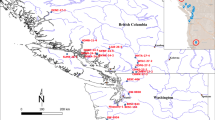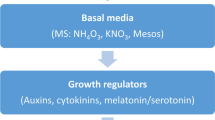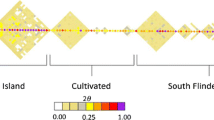Abstract
The F2 and F3 generations of two crosses (6123×13083 and 6123×144, with 6123 the regenerating parent) were evaluated for callus growth and regeneration capacity. Based on joint scaling tests and variance partitioning, neither callus growth nor regeneration fitted a simple additive-dominant genetic model. Heritability estimates obtained from parent-offspring regression analyses ranged from 0.65 to 0.77 for callus growth and from 0.19 to 0.46 for regeneration, with the range in both influenced by the cross and numerical scale employed. Members of two F3 families exhibited much more vigorous and prolific regeneration than the regenerating parental genotype. Because many individuals in the segregating generations showed no evidence of regeneration, population distributions for this trait were severely truncated, or censored. Regression-order analysis was used to estimate means and variances of these censored populations. The association between poor callus growth and high regeneration capacity observed in the parental lines was absent from the F2 and F3 generations, indicating that no association between callus growth and regeneration was present.
Similar content being viewed by others
References
Cavalli L (1952) An analysis of linkage in quantitative inheritance. In Reeve ECR, Waddington CH (eds) Quantitative inheritance. HMSO, London, pp 135–144
Collins GB, Phillips GC (1982) In vitro tissue culture and plant regeneration in Trifolium pratense L. In: Earle ED, Demarly Y (eds) Variation in plants regenerated from cells and tissue culture. Praeger Science Publishers, New York, pp 22–34
Falconer DS (1981) Introduction to quantitative genetics, 2nd Ed Longman, New York
Krottje PA (1995) In vitro morphogenesis and inheritance of in vitro traits in desmodium. PhD dissertation. University of Florida
Mather K, Jinks JL (1971) Biometrical genetics. Cornell University Press, Ithaca, New York
Newman MC, Dixon PM, Looney BB, Pinder JE (1989) Estimating mean and variance for environmental samples with below-detection-limit observations. Water Res Bull 25:905–916
Phillips GC, Collins GB (1979) In vitro tissue culture of selected legumes and plant regeneration from callus cultures of red clover. Crop Sci 19:59–64
Quesenberry KH, Smith RR (1993) Recurrent selection for plant regeneration from red clover tissue culture. Crop Sci 33:585–589
Reisch B, Bingham ET (1980) The genetic control of bud formation from callus cultures of diploid alfalfa. Plant Sci Lett 20:71–77
Wofford DS, Quesenberry KH, Baltensperger DD (1992) Tissue culture regeneration of desmodium. Crop Sci 32:266–268
Author information
Authors and Affiliations
Additional information
Communicated by P. L. Pfahler
Rights and permissions
About this article
Cite this article
Krottje, P.A., Wofford, D.S. & Quesenberry, K.H. Heritability estimates for callus growth and regeneration in desmodium. Theoret. Appl. Genetics 93, 568–573 (1996). https://doi.org/10.1007/BF00417949
Received:
Accepted:
Issue Date:
DOI: https://doi.org/10.1007/BF00417949




